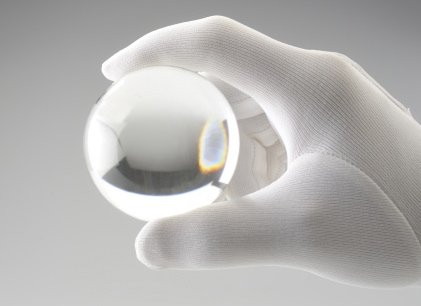It’s still early enough in the year that we’re all still reminding ourselves to write “2013” instead of “2012”—which means that it’s just the right time to be considering what this new year has in store for us. Every news service loves to make predictions, and here at Techonomy we’re no different. So here are our best guesses for what’s to come for the life sciences field in 2013.
$1,000 Genomes for All
For years, the life sciences community has been fueled by a drive to achieve the so-called $1,000 genome—that is, technology that can sequence a full human genome for $1,000 or less. The idea has been that at this price point, genome sequencing will be affordable for patients.
This year, DNA sequencing, which by most accounts has dropped below $10,000, will indeed cross the $1,000 barrier. But what will the effect be? The technical achievement is great, but it will turn the focus to genome interpretation, a far more expensive—and clinically relevant—endeavor. Perhaps we will see another target to drive the field: the new $1,000 genome, wherein the fee covers both sequencing and full analysis of what those DNA bases mean to each person.
In the meantime, we’ll see increasing use of genome sequencing in hospitals and other clinical care settings as the $1,000 price tag makes the technology more accessible for places that couldn’t afford it before. With interpretation still in the development phase, we will not see routine genome sequences for all patients, but certain niches—cancer, idiopathic diseases, pediatric illnesses—are likely to begin embracing this technology on a regular basis.
As a direct result of this drop in sequencing cost, there will be more debate on the appropriateness of using this as a screening method for fetuses and sperm banks. In 2012, several research groups showed that DNA sequencing can be performed on a fetus using cells from the mother’s bloodstream. Combine that with the calls we’re starting to hear for better disease-susceptibility screening in samples at sperm banks, and we expect that 2013 will usher in serious conversation among consumers, bioethicists, and legislators around whether and under what circumstances DNA sequencing at these early stages will be accepted.

National Caution on Finance Means Only Incremental Progress
Though the fiscal cliff crisis may have been averted (or at least kicked down the road a bit), the life sciences research funding landscape will suffer the fallout of all this frenzy about where to make cuts. President Obama has worked hard in the past to maintain stable or even increasing levels of funding for NIH, NSF, and other agencies that support the biomedical enterprise in the United States, but we should expect that the cost-cutting will extend to these agencies.
We are already in an austerity era for science, which means that researchers are reluctant—and will become even more so—to hang their hopes for funding on high-risk projects. Instead, we will see more continuations of existing projects and less of the truly visionary ideas that have been the engine for this country’s scientific innovations. Venture capitalists are playing it safer as well, which means that we’re in for a period of incremental progress rather than projects that really knock it out of the park.
Synthetic Biology Becomes a Household Term
After years of making slow progress in labs you’ve never heard of, along with the occasional whiz-bang engineered genome that doesn’t mean much to regular consumers, synthetic biology will make the mainstream in 2013.
Synthetic biology, which is essentially an engineer’s disciplined approach to modifying biology rather than the scientist’s view of trying to discover what biology does, offers any number of benefits across many industries. In 2012, George Church from Harvard University demonstrated the ability to encode and store an entire book in DNA—a potentially transformative advance for the electronics industry.
Crop science already benefits from synthetic biology (for example, engineering crops that are more resistant to drought or less susceptible to certain pests), but other groups that may be able to use this technology include biofuel developers and pharmaceutical companies. As these various users of synthetic biology begin to make real progress, we expect the field to reach a critical mass and become known far more broadly than in the esoteric scientific corners it is today.
Life Sciences Response to Hurricane Sandy
After the most destructive hurricane that ever hit the East Coast, we expect that Sandy will motivate some in the life sciences industry to tackle problems highlighted by the superstorm and the subsequent blackout. For example, we might see a biofuel that could be safely distributed before a storm as a backup in case of power outages, or that could serve as the fallback power supply for major electrical stations. Or perhaps someone will develop special enzymes that can keep food from going bad when the refrigerator isn’t working. There are plenty of biologists out there with much bigger ideas than we have, and we are looking forward to hearing what they have to contribute to the post-Sandy world.

Identifying Microbial Contamination
In the past, DNA sequencing has mostly been applied after the fact to cases of major outbreaks from tainted food. Generally speaking, the microbes causing these outbreaks can be identified by other technologies faster and less expensively; interest in sequencing the bugs tends to take place once the outbreak is under control to see what else can be learned.
In 2013, we expect this to change. DNA sequencing is now cheap enough and fast enough to be deployed during outbreaks—and scientists have determined that so much more can be mined from the full microbial genome, sometimes even including information on what type of treatment will work best against the bug. We anticipate that the Centers for Disease Control and Prevention, along with other related agencies around the world, will begin to make DNA sequencing their go-to identification tool during these microbial outbreaks.
So there you have it—the things we saw in our handy Techonomy crystal ball. Happy 2013, everyone!

















